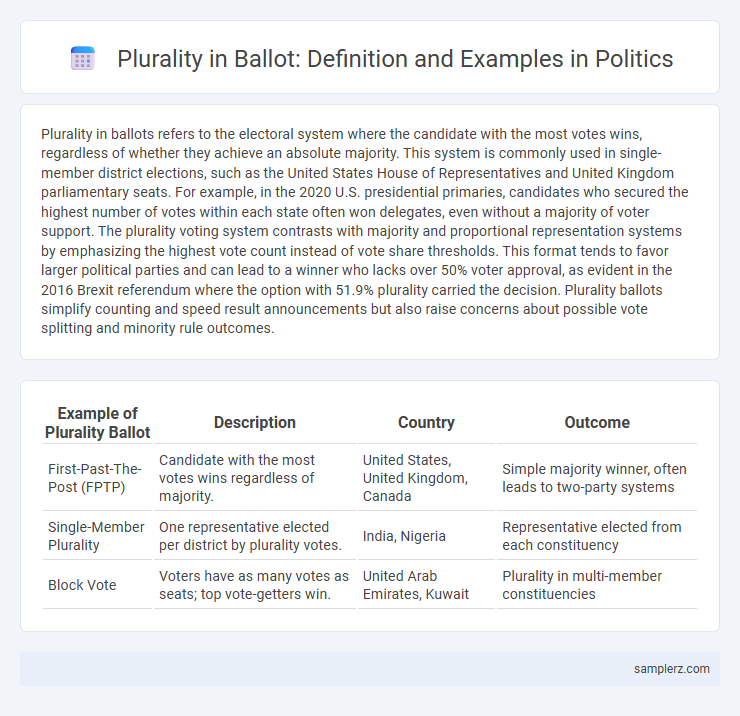Plurality in ballots refers to the electoral system where the candidate with the most votes wins, regardless of whether they achieve an absolute majority. This system is commonly used in single-member district elections, such as the United States House of Representatives and United Kingdom parliamentary seats. For example, in the 2020 U.S. presidential primaries, candidates who secured the highest number of votes within each state often won delegates, even without a majority of voter support. The plurality voting system contrasts with majority and proportional representation systems by emphasizing the highest vote count instead of vote share thresholds. This format tends to favor larger political parties and can lead to a winner who lacks over 50% voter approval, as evident in the 2016 Brexit referendum where the option with 51.9% plurality carried the decision. Plurality ballots simplify counting and speed result announcements but also raise concerns about possible vote splitting and minority rule outcomes.
Table of Comparison
| Example of Plurality Ballot | Description | Country | Outcome |
|---|---|---|---|
| First-Past-The-Post (FPTP) | Candidate with the most votes wins regardless of majority. | United States, United Kingdom, Canada | Simple majority winner, often leads to two-party systems |
| Single-Member Plurality | One representative elected per district by plurality votes. | India, Nigeria | Representative elected from each constituency |
| Block Vote | Voters have as many votes as seats; top vote-getters win. | United Arab Emirates, Kuwait | Plurality in multi-member constituencies |
Definition and Importance of Plurality Voting
Plurality voting, also known as first-past-the-post, is an electoral system where the candidate with the highest number of votes wins, regardless of whether they achieve an absolute majority. This method simplifies election results and often leads to a clear winner, promoting political stability by discouraging fragmented vote splits. Its importance lies in facilitating straightforward vote counting and enabling quick determination of election outcomes, which is critical for efficient governance.
Historical Background of Plurality Ballots
Plurality ballots, also known as first-past-the-post voting, have roots dating back to 19th-century British parliamentary elections where the candidate with the most votes wins without needing a majority. This system was later adopted by the United States and numerous Commonwealth countries, shaping electoral processes by favoring major parties and often simplifying ballot counting. Historical usage of plurality ballots highlights their influence in shaping political party systems and electoral outcomes worldwide.
Key Features of the Plurality Electoral System
The plurality electoral system, also known as "first-past-the-post," awards victory to the candidate with the most votes, even without an absolute majority. Key features include single-member districts, straightforward vote counting, and a tendency to favor larger political parties while often marginalizing smaller groups. This system encourages tactical voting and usually produces clear winners, which can lead to stable majority governments but may reduce proportional representation.
Case Study: Plurality Voting in United States Elections
Plurality voting, also known as first-past-the-post, is the dominant electoral system in United States elections, where the candidate with the most votes wins regardless of whether they achieve an absolute majority. This system is prominently used in presidential, congressional, and state legislative contests, often leading to a two-party dominance between Democrats and Republicans. Critics argue that plurality voting can marginalize third-party candidates and reduce electoral competitiveness, influencing campaign strategies and voter turnout.
Example of Plurality in British Parliamentary Elections
In British Parliamentary elections, plurality voting is exemplified by the First-Past-The-Post (FPTP) system, where the candidate with the most votes in a constituency wins a seat without needing an absolute majority. This plurality voting mechanism often results in single-party majority governments despite winning less than 50% of the total national vote. The FPTP system emphasizes local data distribution over nationwide vote shares, influencing party strategies and representation in the House of Commons.
Advantages and Disadvantages of Plurality Ballots
Plurality ballots simplify voting by allowing the candidate with the most votes to win, which can lead to quicker election results and less voter confusion. This system often encourages a two-party dominance, potentially marginalizing smaller parties and reducing political diversity. However, plurality voting may result in winners who do not have majority support, raising questions about the representativeness and fairness of election outcomes.
Plurality versus Majority: Key Differences
Plurality in ballots occurs when a candidate receives more votes than any other but less than an absolute majority, often leading to winners with less than 50% support, unlike majority systems that require over half the votes for victory. This difference significantly impacts electoral outcomes, as plurality can result in victories by divided electorates, while majority voting promotes broader consensus. Understanding these distinctions clarifies why electoral strategies and voter behavior vary between plurality and majority frameworks.
Impact of Plurality Voting on Political Parties
Plurality voting often leads to a two-party system as smaller parties struggle to win seats despite significant vote shares, reducing political diversity. This system incentivizes major parties to adopt broad platforms, sometimes marginalizing niche or emerging political movements. Consequently, voters may feel compelled to choose the "lesser of two evils," impacting party strategies and voter representation.
Criticisms and Challenges Associated with Plurality Systems
Plurality voting systems often face criticism for enabling the election of candidates without majority support, which can lead to questions about the democratic legitimacy of outcomes. These systems tend to marginalize smaller political parties, reducing electoral competitiveness and limiting diverse representation in legislatures. Furthermore, plurality voting can encourage strategic voting, where voters select not their preferred candidate, but the one most likely to defeat a less favored contender, thereby distorting true voter preferences.
Prospects for Reform: Alternatives to Plurality Voting
Alternatives to plurality voting, such as ranked-choice voting and proportional representation, offer promising prospects for enhancing electoral fairness and representation. Ranked-choice voting allows voters to rank candidates by preference, reducing spoiler effects and encouraging more diverse candidate participation. Proportional representation allocates seats based on the percentage of votes each party receives, promoting a multiparty system and better reflecting the electorate's preferences.

example of plurality in ballot Infographic
 samplerz.com
samplerz.com